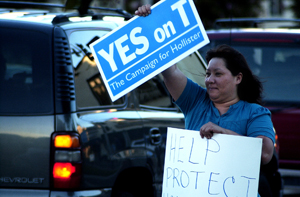City council still needs to decide on committee, fund use
On November 6 voters passed a measure that will raise
Hollister’s taxes and generate between $3.5 and $4 million
annually. But in the weeks after the election, city officials
aren’t ready to announce where the money will go or how it will be
overseen.
City council still needs to decide on committee, fund use
On November 6 voters passed a measure that will raise Hollister’s taxes and generate between $3.5 and $4 million annually. But in the weeks after the election, city officials aren’t ready to announce where the money will go or how it will be overseen.
Hollister voters passed Measure T, a sales tax initiative, by 66 percent. The city council’s next step is to figure out how the citizen oversight committee will be chosen and how the public will voice its priorities.
Neither will be decided until the end of December, said Doug Emerson, a Hollister city council member.
Emerson said he is glad the measure passed.
“I think the public realized that the need is there,” Emerson said.
Measure T’s passage demonstrates that the public has some faith in the council, he said.
The turnout for the election was 26 percent. The measure passed by more than 2,700 yes votes to 1,416 no votes.
Voters had confidence in the city council. Other residents expressed concern that the money will be used properly.
“The priority should be all the departments that were cut back,” said Stephen Rosati, co-owner of Pennywise Drug on San Benito Street in Hollister. “I’m one that believes that when you’re coming in with new taxes, there should be a specific use for the money.”
Another resident expressed less faith in the council.
“When they pass a tax law [the money] never goes where they say the money’s going to go,” said Jim Jackson, a Hollister resident. “In my opinion, I don’t think one dime of that will go to police and firemen.”
The measure will increase the city’s sales tax by 1 percent as of April, Emerson said. The measure will generate between $3.5 and $4 million annually and expire in five years.
The council will probably not discuss Measure T until December, Emerson said.
“I’m not in any rush to get things done real fast. I would much rather go slower, make sure everybody is on the same page,” he said, referring to the council and the community.
Measure T necessitates the citizen oversight committee. The committee will report annually to the community about how city officials spent the Measure T money, Quilter said.
The council will probably put the committee together during January and February, Emerson said.
There are various options for how the public will have the opportunity to voice its priorities for spending the Measure T money. Surveys and public meetings are two possibilities.
“The public can always speak to the council [during] public meetings,” Emerson said. “They can do that Monday night.”
For citizens who have concerns about Measure T, the first official city council meeting since Measure T passed will be on Mon., Nov. 19, said Clint Quilter, Hollister city manager. Measure T will not be on the agenda, but the citizens can always speak to the council during the public comment period.
City officials do not plan to extend the tax beyond the five-year sunset, Quilter said.
Hollister’s economy must grow between 5 and 6 percent annually to cover the revenue lost after Measure T expires. That is a reasonable rate of growth, he said.
“We’re putting a substantial amount of effort toward economic growth,” Quilter said. “You would hope that those efforts will bear fruit at the end of five years.”
Based on sales tax, the rate of growth in this region of California was between 1 and 3 percent over the past few years, said Jeff Pyle, the economic development manager for Hollister
Referring to a growth rate of 5 and 6 percent, he said, “that’s a pretty aggressive rate of growth.”
Due to the moratorium on building, there is a large pent up demand for development, Quilter said.
“A number of businesses would like to open up here, when they can,” he said. “We have a Lowe’s coming here.”
After the moratorium ends things are going to change, Emerson said.
“Five years from now things are going to be dramatically different than they are now,” he said, referring to development.
After Measure T kicks in, city officials will start to do projections for city services that generate revenue, such as building permits and licenses, Emerson said. That will give officials an idea of how much revenue the economy will generate for the city’s general fund.
In a few years city officials will check to make sure that the projections are on track with reality, Emerson said.










